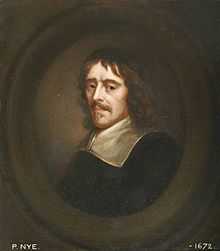Philip Nye

Philip Nye (c. 1595-1672) was a leading English Independent theologian.
Life
He graduated with an M.A. from Magdalen Hall, Oxford in 1622. He spent the years 1633 to 1640 in exile, in Holland.[1]
He was one of the Five Dissenting Brethren in the Westminster Assembly, and a leader of the group alongside Thomas Goodwin.[2] With support from Lord Kimbolton[3] he had influential connections with the Parliamentary Army,[4] and also had the living of Kimbolton, then in Huntingdonshire. He acted as an adviser to Oliver Cromwell on matters around regulation of the Church.[5] According to Ivan Roots, the eventual ecclesiastical settlement under the Protectorate followed closely proposals from 1652, outlined by Nye with John Owen and others.[6]
He later had the parish of Acton. He was employed by Parliament, on a mission to the imprisoned Charles I, and as a trier of preachers. He is mentioned in Hudibras.[7]
On toleration
With Goodwin, he was a co-author of the Apologeticall Narration, pleading for toleration of Calvinist congregations outside a proposed Presbyterian national church.[8] The presented the text to parliament on 3 January 1644. They argued that the congregational churches were closer to the practice of the early Christians and also that they were more suited to the changeability of contemporary times. This tactic meant they could avoid having their views debated at the Westminster Assembly, where they would have been readily outnumbered, and perhaps outvoted.[9] In the Whitehall Debates of 1648, however, he supported Henry Ireton’s view that toleration should be limited by the state. He was one of those agitating successfully against the Racovian Catechism.[10]
Views
He was an opponent of astrology.[11]
Publications
- Philip Nye (1643), Two speeches delivered before the subscribing of the Covenant, the 25. of September, at St. Margarets in Westminster, Edinburgh: Printed by Robert Bryson
- Philip Nye (1643), An exhortation to the taking of the Solemne League and Covenant for reformation and defence of religion, the honour and happinesse of the King, and the peace and safety of the three kingdomes of England, Scotland, and Ireland, London: s.n.
- Philip Nye (1644), An exhortation to the taking of the Solemne league and covenant for reformation and defence of religion, the hononr [sic] and happinesse of the king, and the peace and safety of the three kingdomes of England, Scotland, and Ireland, Printed at London: For Ralph Smith ...
- Philip Nye (1646), The Excellency and Lawfulnesse of the Solemne League and Covenant, London: Printed by W. Wilson
- Philip Nye (1658), A declaration of the faith and order owned and practised in the Congregational Churches of England; agreed upon and consented unto by their elders and messengers in their meeting at the Savoy, October 12. 1658, London: Printed by John Field
- Philip Nye (1660), Beames of former light, discovering how evil it is to impose doubtfull and disputable formes or practises, upon ministers, London: Printed by R.I. for A. Byfield
- Philip Nye (1662), The lawfulnes of the oath of supremacy and power of the civil magistrate in ecclesiastical affairs: and subordination of churches thereunto, London: printed by Peter Cole at the Printing-press in Cornhil neer the Royal Exchange
- Philip Nye (1677), A case of great and present use, London: [s.n.]
- Philip Nye (1683), The lawfulnes of hearing the publick ministers of the Church of England proved, London: Printed for Jonathan Robinson ...
- Philip Nye (1683), The lawfulnes of the oath of supremacy, and power of the King in ecclesiastical affairs, London: Printed for Jonathan Robinson ..., and Samuel Crowch ...
- Philip Nye (1687), 's_authority_in_dispensing_with_ecclesiastical_laws_asserted_and_vindicated The King's authority in dispensing with ecclesiastical laws asserted and vindicated, London: Printed for H.N. and Nathanael Ranew ...
Notes
- ↑ Concise Dictionary of National Biography
- ↑ The Westminster Confession of Faith
- ↑ The future Edward Montagu, 2nd Earl of Manchester.
- ↑ , PDF, p. 6.
- ↑ G. E. Aylmer, Rebellion or Revolution? (1986), p. 179.
- ↑ The Great Rebellion (1995 edition), p. 176.
- ↑ Acton | British History Online
- ↑ Claire Cross, The Church of England 1646-1660 p. 101, in The Interregnum (1972), edited by G. E. Aylmer.
- ↑ C.V. Wedgewood (1958), 's_War_1641_-_1647 The King's War 1641 - 1647, Collins, p. 285
- ↑ ,
- ↑ Christopher Hill, The English Bible and the Seventeenth-Century Revolution (1993), p. 24; Keith Thomas, Religion and the Decline of Magic, p. 436.